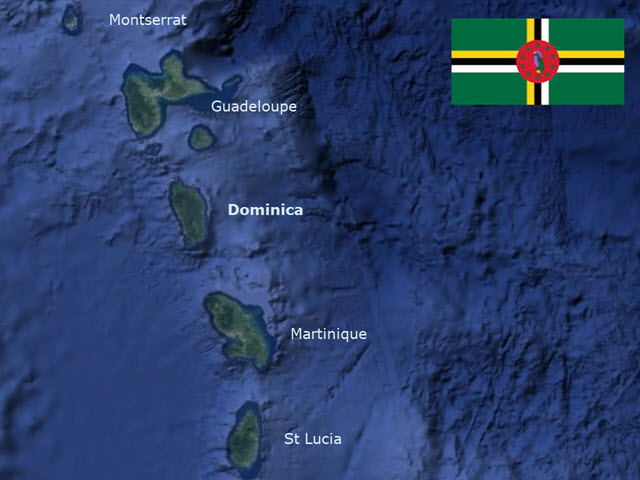Basic Facts
Capital: Roseau
People/Customs: Population is around 71,000, with one third residing in the capital. There are about 3000 native Caribs living in the Calingo reservation area.
Language: English (Locals also use a French Patois when speaking to each other.)
Climate: In the winter the high is around 81°, the low, 72°. In the summer, the high is 86°, the low, 77°. Hurricane Season is from June to November.
Food/Farming: bananas, coconuts, spices, coffee, cacao, citrus, cucumbers, melons, and a variety of tropical fruits are grown for export as well as local use. There is a coconut processing plant on the island which produces oil for cooking and cosmetics.
Government: Dominica is an independent republic within the British Commonwealth.
Currency: East Caribbean Dollar
Art/Music/Culture: Holidays are New Year’s Day, Carnival, Good Friday, Easter Monday, May Day, Whit Monday, August Monday (Emancipation Day), Independence Day, Community Service Day, Christmas Day, and Boxing Day. The culture is influenced by the French islands to the north and south.
History
Columbus named the island Dominica in 1493 because he first sighted the island on a Sunday, and in Italian Doménica means Sunday. The Spaniards took little notice of Dominica because there was no gold and the natives defended their island fiercely. In 1635 France attempted to colonize Dominica, but were thwarted by the Caribs. The French and British agreed to leave the island to the natives in 1660, but the French settlers from Guadeloupe and Martinique secretly established coffee plantations on the north end of Dominica. In the 1720’s a French governor came to take official control of the island. For the rest of the 18th century the British and French fought over Dominica until the Treaty of Paris was signed in 1763, officially giving the island to the British. The Europeans imported slaves from Africa to work the land until emancipation in 1834. Dominica became an associated state in 1967, and in 1978 it gained independence as a republic within British Commonwealth. The economy is now based largely on agriculture and tourism, with the natural beauty of the island a large draw for those who love hiking, waterfalls, and snorkeling/diving.
Land Forms/Flora and Fauna
Dominica is 190 square miles, and has the highest mountains in the eastern Caribbean. Morne Diablotin is 4747 feet high and attracts the rain that creates the 200 rivers on the island. Dominica also has the highest concentration of live volcanoes. Dominica has many tropical rainforest birds and animals, including the “mountain chicken,” a large frog considered to be a delicacy by the locals. Most of Dominica is unspoiled wilderness, earning it the nickname, “the Nature Island.”
Things to do
Hike 16 miles to the largest boiling lake in the world (heated by the magma chambers below), take a river tour and go to the rainforest café, visit waterfalls, and hike or snorkel in Cabrits National Park and visit the old fort. Champagne reef to the south has underwater volcanic vents which create bubbles in the water, as well as warm sulfur springs in Soufriere Bay popular with bathers.
Bibliography
Bendure, Glenda and Ned Friary. “Dominica.” Lonely Planet Guide to the Eastern Caribbean, 2nd Edition. 1998: Lonely Planet, Hawthorn, Australia.

